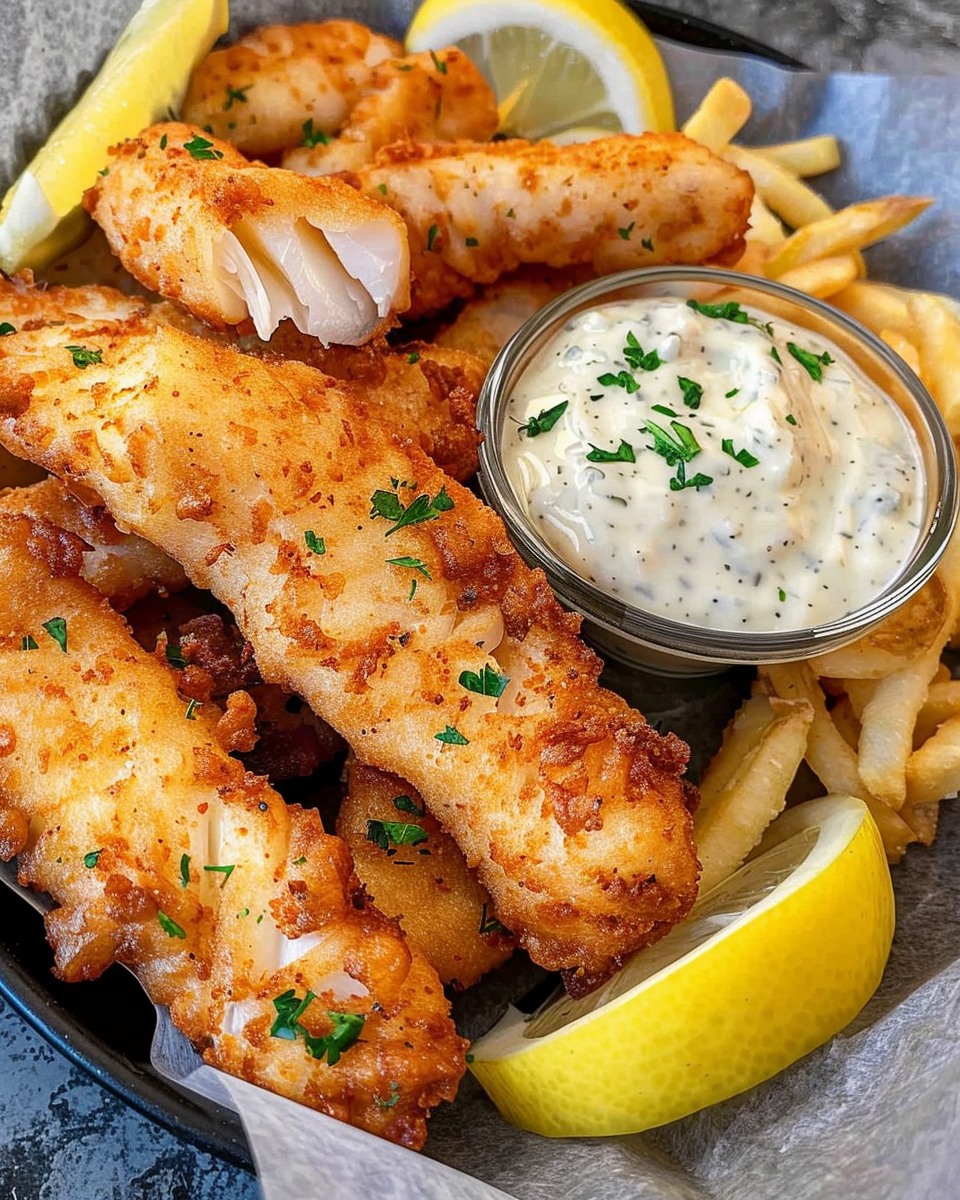Introduction
Overview of Fish Sticks with Tartar Sauce
Fish sticks are a classic dish, celebrated for their simplicity and comforting appeal. These breaded and crispy fish pieces are paired with tartar sauce, a creamy, tangy condiment that elevates the dish to new heights. Whether you’re preparing a quick family dinner or an easy party appetizer, fish sticks with tartar sauce offer both convenience and delicious flavor.
Why Fish Sticks?
Fish sticks are adored for several reasons: they are incredibly convenient, making them perfect for busy weeknights. They offer a satisfying crunch and a tender interior, appealing to both kids and adults alike. Beyond their taste, fish sticks are a versatile ingredient that can fit into various diets, especially when made with healthy ingredients.
The Role of Tartar Sauce
Tartar sauce plays a crucial role in balancing the crispy texture of the fish sticks with its creamy and tangy profile. This sauce adds a layer of complexity to the dish, making each bite more flavorful. It complements the fish sticks perfectly, offering a refreshing contrast to the fried or baked exterior.
Ingredients
Choosing the Right Fish
- Types of Fish Suitable for Fish Sticks: Cod, haddock, and tilapia are ideal choices. Cod offers a mild flavor and flaky texture, haddock provides a slightly stronger taste, and tilapia is known for its mildness and affordability.
- Fresh vs. Frozen Fish: Fresh fish provides superior flavor and texture, but high-quality frozen fish can be a convenient and cost-effective alternative. When using frozen fish, make sure to thaw it properly to avoid a watery texture.
- Tips for Selecting High-Quality Fish: Look for fish with a firm texture and a clean, ocean-like smell. Avoid fish with any off-putting odor or slimy texture.
Ingredients for Fish Sticks
- Fish Fillets: Cut the fillets into uniform sticks to ensure even cooking. Pat them dry to remove excess moisture, which helps the breading adhere better.
- Breading and Coating: The classic method involves a three-step breading process: dredging in flour, dipping in beaten eggs, and coating with breadcrumbs. Panko breadcrumbs are preferred for their extra crispiness.
- Seasonings: Simple seasonings like salt, black pepper, paprika, and garlic powder enhance the flavor without overwhelming the fish.
Ingredients for Tartar Sauce
- Mayonnaise: The base of tartar sauce, providing creaminess. Opt for high-quality, unsalted mayonnaise.
- Pickles: Dill pickles are commonly used for their tangy flavor. Chop them finely to distribute their taste evenly throughout the sauce.
- Additional Flavorings: Capers add a briny touch, lemon juice brings brightness, and Dijon mustard adds a subtle tang.
- Herbs and Spices: Fresh parsley and a bit of salt and pepper round out the flavor profile of the sauce.
Optional Ingredients
- Additional Spices for Fish Sticks: For extra kick, consider adding cayenne pepper or onion powder to the breading mixture.
- Variations of Tartar Sauce: Experiment with adding hot sauce for a spicy twist or extra herbs like dill for a fresh flavor.
Instructions: Step-by-Step
Step 1: Preparing the Fish Sticks
- Preparing the Fish Fillets: Begin by cutting the fish fillets into even sticks, about 1 inch wide. This ensures uniform cooking. Pat the sticks dry with paper towels to remove excess moisture.
- Seasoning the Fish: Season the fish sticks with salt, black pepper, paprika, and garlic powder. This basic seasoning enhances the fish’s natural flavor without overpowering it.
Step 2: Breading the Fish Sticks
- Setting Up a Breading Station: Arrange three shallow dishes: one with flour, one with beaten eggs, and one with breadcrumbs. The flour helps the egg adhere, while the egg helps the breadcrumbs stick.
- Coating the Fish Sticks: Dredge each fish stick in flour, shaking off excess. Dip into beaten eggs, then coat thoroughly with breadcrumbs. Press gently to ensure an even coating.
Step 3: Cooking the Fish Sticks
- Baking Method: Preheat your oven to 400°F (200°C). Arrange the breaded fish sticks on a baking sheet lined with parchment paper or a lightly greased rack. Bake for 15-20 minutes, or until golden brown and crispy. Flip halfway through for even cooking.
- Frying Method: Heat oil in a large skillet over medium-high heat. Fry the fish sticks in batches, without overcrowding, for about 3-4 minutes per side, or until golden brown and cooked through. Drain on paper towels to remove excess oil.
- Tips for Perfectly Cooked Fish Sticks: Ensure the oil is hot enough if frying, and avoid overcrowding the pan. For baking, make sure the fish sticks are spaced evenly to ensure crispiness.
Step 4: Preparing the Tartar Sauce
- Making the Base Sauce: In a bowl, mix mayonnaise with finely chopped pickles. Stir until well combined.
- Adding Flavorings: Incorporate capers, lemon juice, and Dijon mustard into the mixture. Adjust to taste.
- Adjusting Seasoning: Taste the sauce and adjust seasoning with salt and pepper. Add more lemon juice or mustard if desired.
Step 5: Serving the Fish Sticks
- Presentation: Arrange the cooked fish sticks on a serving plate or tray. Garnish with fresh parsley for a pop of color.
- Accompanying the Tartar Sauce: Serve the tartar sauce in a small bowl or ramekin alongside the fish sticks for dipping.
Serving Suggestions
Classic Pairings
- Side Dishes: Pair fish sticks with classic sides like crispy French fries, tangy coleslaw, or a fresh green salad.
- Vegetable Options: Steamed or roasted vegetables, such as broccoli or carrots, provide a healthy complement to the meal.
Sauces and Condiments
- Additional Sauces: Besides tartar sauce, consider serving ketchup, lemon aioli, or a spicy hot sauce for variety.
- Condiments: Offer a selection of condiments to cater to different tastes, including malt vinegar or BBQ sauce.
Garnishes
- Herbs: Fresh parsley or chives add a touch of color and freshness.
- Citrus: Lemon wedges provide a bright, zesty contrast to the rich fish sticks.
Beverage Pairings
- Wine Recommendations: Light and crisp wines like Sauvignon Blanc or Chardonnay pair well with the flavors of the dish.
- Non-Alcoholic Options: Sparkling water or a refreshing iced tea make excellent non-alcoholic choices.
Conclusion
Recap of the Recipe
This article covers the process of making delicious fish sticks with tartar sauce, from selecting the right fish to preparing and cooking it to perfection. The accompanying tartar sauce adds a creamy, tangy element that complements the crispy fish sticks beautifully.
Encouragement to Experiment
Feel free to experiment with different seasonings for the fish sticks or variations of tartar sauce to suit your taste preferences. Adding a touch of spice or trying different herbs can personalize the dish.
Final Thoughts
Fish sticks with tartar sauce are a versatile and satisfying dish, perfect for any occasion. Whether served as a quick weeknight dinner or a casual gathering appetizer, this classic combination offers both comfort and flavor.
FAQs
Can I Use Frozen Fish for Fish Sticks?
Yes, frozen fish can be used for fish sticks. Ensure it is properly thawed before preparation to maintain the best texture. Follow the instructions for thawing and patting dry to avoid excess moisture.
What Can I Use Instead of Breadcrumbs?
If you prefer, you can use crushed crackers, panko breadcrumbs, or gluten-free breadcrumbs as alternatives. Each option offers a slightly different texture, but all work well for achieving a crispy coating.
How Do I Make Tartar Sauce Ahead of Time?
Tartar sauce can be made in advance and stored in the refrigerator for up to a week. Prepare the sauce, store it in an airtight container, and give it a good stir before serving.
How Do I Ensure the Fish Sticks Stay Crispy?
To keep fish sticks crispy, avoid overcrowding the pan or baking sheet. For frying, ensure the oil is at the right temperature and for baking, flip the fish sticks halfway through the cooking time. Store cooked fish sticks on a rack to prevent sogginess.
Can I Bake the Fish Sticks Instead of Frying?
Yes, baking is a healthier alternative to frying. Preheat the oven to 400°F (200°C), place the fish sticks on a baking sheet, and bake for 15-20 minutes. They will be less oily but still crispy and delicious.

